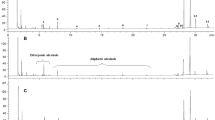Abstract
The fatty acid (FA) composition of Oenocarpus bataua oil from 38 samples collected over a large geographical range (i.e. French Guiana and Peru) was analyzed. Fifteen fatty acids were obtained from the mesocarp of this palm species. Oleic (72.7%) and palmitic (18.1%) acids were the predominant FAs. Minor FAs were cis-vaccenic acid (2.3%), linoleic acid (1.9%), stearic acid (1.7%), palmitoleic (0.9%) and alpha-linolenic acid (0.8%). The mean lipid content of the dry mesocarp was 51.6%. The O. bataua oil samples analyzed were remarkably rich in α-tocopherol. By contrast, the other fractions of the unsaponifiable matter (sterols, carotenoids) did not show any noteworthy specificity in comparison with common vegetable oils. However, the particularly high percentage in Δ5-avenasterol of O. bataua oil could serve as a marker for its authentication. Results are discussed in terms of the potential nutritional value of O. bataua oil.
Similar content being viewed by others
References
FAO (1994) Fats and oils in human nutrition. Report of a Joint FAO/WHO Expert Consultation. FAO Food and Nutrition Paper 57. Food and Agriculture Organization, Rome
WHO (2002) Diet, Nutrition, the Prevention of Chronic Diseases: Report of a Joint WHO/FAO Expert Consultation, Geneva, 28 Jan–1 Feb. WHO Technical Report Series: 916. World Health Organization, Geneva
Balick MJ (1986) Systematics and Economic Botany of the Oenocarpus–Jessenia (Palmae) complex. Adv Econ Bot 3:1–140
Balick MJ, Gershoff SN (1981) Nutritional evaluation of the Jessenia bataua palm: source of high quality protein and oil from Tropical America. Econ Bot 35:261–271
Lleras E, Coradin L (1988) Native neotropical oil palms: state of the art and perspectives for Latin America. Adv Econ Bot 6:201–213
Miller C (2002) Fruit production of the Ungurahua palm (Oenocarpus bataua subsp. bataua, Arecaceae) in an indigenous managed reserve. Econ Bot 56:165–176
Macia M (2004) Multiplicity in palm uses by the Huaorani of Amazonian Ecuador. Bot J Linn Soc 144:149–159
Lubrano C, Robin JR (1997) Étude des composés majeurs d’huiles de pulpe de fruits de six espèces de palmiers de Guyane. Acta Bot Gallica 144:497–499
Alemán R, Belén DR, Zorilla M, Bastardo L, Alvarez F, Moreno-Alvarez MJ (2002) Características fisicoquímicas del aceite del mesocarpio de la coroba (Jessenia polycarpa Karst). Grasas Aceites 53:396–399
Mambrim MCT, Barrera-Arellano D (1997) Caracterización de aceites de frutos de palmeras de la región amazónica del Brasil. Grasas y Aceites 48:154–158
Rios A, Fito P, Graciani E, Rodriguez A (1997) Evaluación de la calidad del aceite de la palma Jessenia bataua de la región del Pacífico colombiano. Alimentaria 286:123–128
Phillips KM, Ruggio DM, Toivo JI, Swank MA, Simpkins AH (2002) Free and esterified sterol composition of edible oils and fats. J Food Compos Anal 15:123–142
Montufar M, Pintaud JC (2008) Taxonomic status of Oenocarpus bataua (Euterpeae, Arecaceae) inferred from plastid sequences. Rev Peru Biol 15:073–078
Covas MI, Ruiz-Gutiérrez V, De La Torre R, Kafatos A, Lamuela-Raventós RM, Osada J, Owen RW, Visioli F (2006) Minor components of olive oil: evidence to date of health benefits in humans. Nutr Rev 64:20–30
Laffargue A, de Kochko A, Dussert S (2007) Development of solid-phase extraction and methylation procedures to analyse free fatty acids in lipid-rich seeds. Plant Physiol Biochem 45:250–257
Reiter B, Lechner M, Lorbeer E (1998) The fatty acid profiles-including petroselinic and cis-vaccenic acid of different Umbelliferae seed oils. Fett/Lipid 100:498–502
Gordon MH, Magos P (1983) The effect of sterols on the oxidation of edible oils. Food Chem 10:141–147
Bereau D, Benjelloun-Mlayah B, Banoub J, Bravo R (2003) FA and unsaponifiable composition of five Amazonian palm kernel oils. J Am Oil Chem Soc 80:49–53
Goh SH, Choo YM, Ong SH (1985) Minor constituents of palm oil. J Am Oil Chem Soc 62:237–240
Rodrigues-Amaya DB (1996) Assessment of the provitamin A contents of foods–the Brazilian experience. J Food Compos Anal 9:196–230
Tuberoso CIG, Kowalczyk A, Sarritzu E, Cabras P (2007) Determination of antioxidants compounds and antioxidant activity in commercial oilseeds for food use. Food Chem 103:1494–1501
Azzi A, Stocker A (2000) Vitamin E: non-antioxidant roles. Prog Lipid Res 39:231–255
Salazar E, Belén D, Jiménez N, Pino K (2004) Características físico-químicas del aceite de la semilla de la coroba (Jessenia polycarpa Karst). Grasas y Aceites 55:423–427
Ucciani E (1995) Nouveau Dictionnaire des huiles végétales. Composition en acides gras, Lavoisier
Acknowledgments
We thank Betty Millán of Universidad Nacional Mayor San Marcos (UNMSM, Peru), Jean-Jacques de Granville of Herbier de Guyane (France) and Jean-Louis Pham (IRD) for their support during this project. We also wish to acknowledge the Instituto de Investigaciones de la Amazonia Peruana (IIAP), and particularly the staff of the Jenaro Herrera Research Station (JHRS), and the staff of the Herbier de Guyane for providing logistical support and working facilities. R. Montúfar is grateful to Italo Melendez, Victor Hugo Vargas and Domingo for field assistance. Fieldwork in Peru was carried out under an international agreement between IRD (France) and UNMSM (Peru).
Author information
Authors and Affiliations
Corresponding author
About this article
Cite this article
Montúfar, R., Laffargue, A., Pintaud, JC. et al. Oenocarpus bataua Mart. (Arecaceae): Rediscovering a Source of High Oleic Vegetable Oil from Amazonia. J Am Oil Chem Soc 87, 167–172 (2010). https://doi.org/10.1007/s11746-009-1490-4
Received:
Revised:
Accepted:
Published:
Issue Date:
DOI: https://doi.org/10.1007/s11746-009-1490-4




